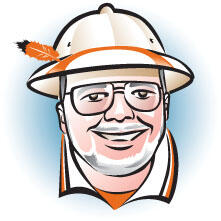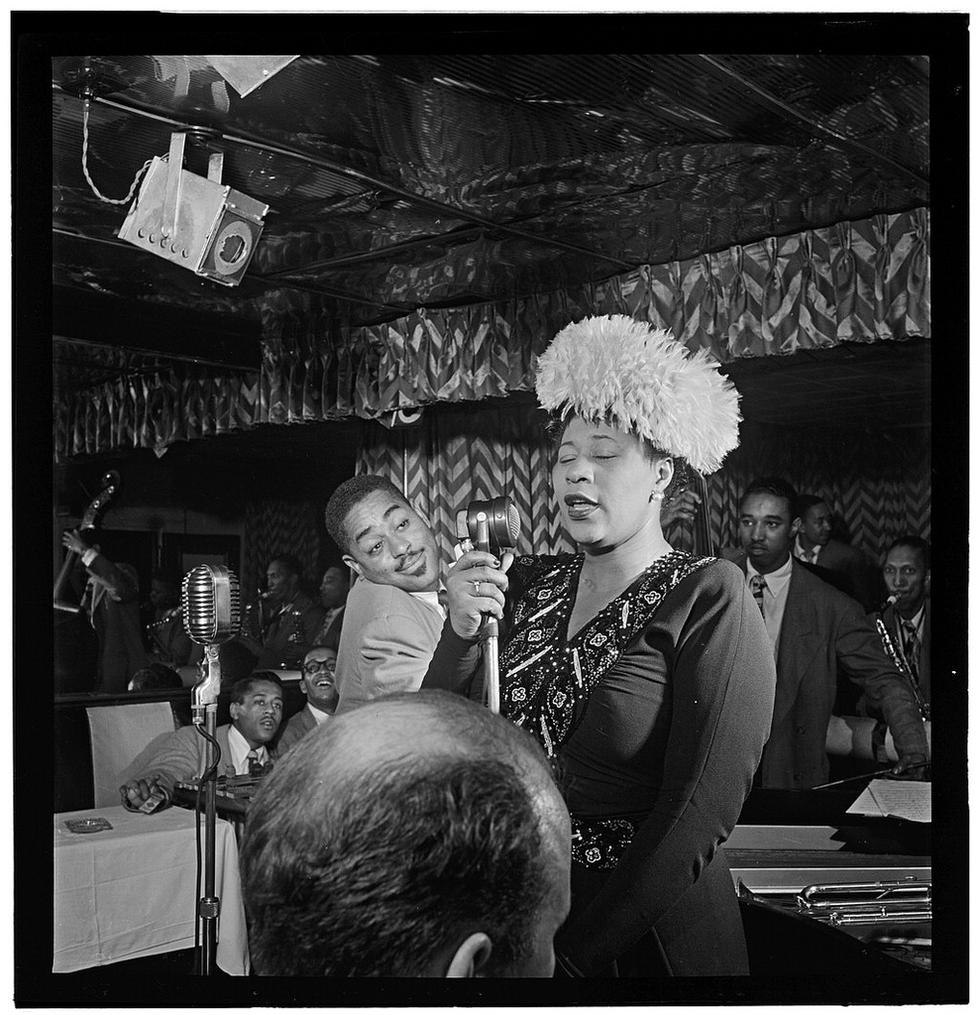Stars shining bright above you,
Night breezes seem to whisper “I love you,”
Birds singin’ in the sycamore tree;
Dream a little dream of me.
So the hot news on campus is the resuscitation of the big fall football weekend dance. Now apparently rocking under the sobriquet of Orange and Black Ball, it used to be Prince-Tiger, and that of course requires a tail…
Now, calling Ella Fitzgerald a singer is something like calling the University Chapel a pleasant room. While her songs (and they were songs, not arias or anthems) were made of the same material as everybody else’s, the architecture, color, and grandeur that she infused – often on the spur of the moment – made them as memorable as any grand concert hall or sacred space you’ve ever encountered. I double-dog dare you to listen to this rendition of a Louis Armstrong standard recorded in 1963 at her zenith, and then not listen again. It’s a sound both nonhuman and superhuman at the same time, so perfect (her pitch was never off that anybody ever heard, across an impossible three-octave range) that it seems to come directly from the orchestra and the moon at the same time, anywhere and everywhere but from a round, shy woman who always wanted her manager to speak for her. How was this accomplished? According to Fitzgerald, “I stole everything I ever heard, but mostly I stole from the horns.” I n more than 50 years of simply trying to fit in enough to make a living, she met and utterly dominated swing, jazz, pop, blues, and scat, and essentially created be-bop (named for a line in her 1939 “ T’ain’t What You Do, It’s the Way That You Do It” ) and the very idea of the Great American Songbook through a series of landmark recordings in the ’50s and ’60s. Sinatra willingly bowed to her voice and stylings; Ira Gershwin said of brother George and himself: “I never knew how good our songs were until I heard Ella Fitzgerald sing them.”
This was, of course, all still in the future on Nov. 20, 1936. She was only two years removed from her public debut, in an amateur contest at the fabled Apollo (she wanted to dance, but was too intimidated by the competition, so she sang instead). Bandleader Chick Webb then heard her at the Harlem Opera House and signed her on the spot. Her “swell” recording of Sam Stept’s “All My Life” already had been reviewed in the Prince, which was crazy about jazz in those days; she already had performed on national radio with Benny Goodman, one of the first bandleaders to integrate his forces. Webb and his band (the self-proclaimed “newest colored sensation”) were booked to play Prince-Tiger, the big formal dance of the fall sponsored by the two publications (for those of you tender youth who matriculated after 1970), the night before the Dartmouth game. The place went nuts. She played for the Prince again at a gala dance replacing Prince-Tiger on Nov. 14, 1942 – in the ballroom of the Plaza in New York no less ($4.40 per couple), since that year’s Yale game was being played in the city and the administration had forbidden proms in Princeton for the duration of the war. By this time, the band was Fitzgerald’s – Webb had died in 1939 – and she was recognized as a force in the recording business. She took time at the dance to unofficially declare the Nassoons the victors in a sing-off over Yale’s Whiffenpoofs (at 1 a.m. following the game, one might reasonably suspect that none involved was at the peak of his skills).
It was 25 years before Fitzgerald and the Tigers crossed paths again; her first concert at McCarter was on March 29, 1967. By then, she had been a solo act for years and was billed as “the First Lady of Song,” with very little dissent remaining in the pop world; her monumental songbook recordings completed three years before had pretty much retired the trophy. At 50 years old, she already had received a Grammy for lifetime achievement.
She returned to sing in Princeton once more, 15 years later. By then, she had recorded more than 200 albums and sold 40 million copies of them. An international idol, she later received the Presidential Medal of Freedom. She performed 26 solo shows at Carnegie Hall. In the end, her health gave out after an endless lifetime of one-night gigs, and she died in 1996 at age 79.
But not before Princeton formally recognized the huge cultural influence of the simple song, in the person of its pre-eminent ennobler. On June 12, 1990, Ella Fitzgerald received an honorary doctor of music degree from Princeton, where she had sung at the big fall dance 54 years earlier. She was cited for a voice “as flexibly virtuosic as an instrument and as warmly human as she,” and more to the point, for “chasing the blues away.” The import of the gesture is hard to overstate; in its history, the University has honored exactly three people whose principal field was popular music – the others are Quincy Jones (the multitalented producer, composer, musician, and philanthropist, who did arrangements for Fitzgerald in the ’60s) in 2008, and the utterly singular Bob Dylan in 1970. As light and smooth as her repertoire was, this was not an honor lightly bestowed; it was an emphatic statement about the potential power of the accessible in our lives. In a universe seemingly dominated by string theorists, molecular biologists, and marginally sane economists, it is a great comfort to understand the brilliance of a Harold Arlen song or a snazzy jazz interlude performed to perfection by the lone human voice. It recalls and restates that most American of sentiments, ably put forth by another of Fitzgerald’s myriad collaborators, Duke Ellington:
What good is melody, what good is music
If it ain't possessin' something sweet
It ain't the melody, it ain't the music
There's something else that makes the tune complete
It don't mean a thing, if it ain't got that swing
It don't mean a thing, all you got to do is sing
It makes no diff'rence if it's sweet or hot
Just give that rhythm ev'rything you got
It don't mean a thing, if it ain't got that swing













No responses yet